
The Whitsundays Comes Alive For The Coral Sea Marina Resort Airlie Beach Triathlon Festival This Weekend! The day we’ve all been waiting for is finally here! Tomorrow, the Coral Sea Marina Resort Airlie Beach Triathlon Festival kicks off, and the energy is already electric. The iconic shoreline of Airlie Beach is buzzing with athletes, supporters, and organisers, all preparing for a weekend that promises to be a true highlight on the triathlon calendar. This festival is a celebration of our st
Read the full story
Hi Everyone, It’s great to be back and feeling refreshed after a quick—but absolutely wonderful—two-week holiday in Italy. My family and I stayed in a small villa in a town three hours north of Rome called Radicondoli. With only 950 residents, it felt like by the end of the trip, we’d made friends with most of them! This was the first holiday in recent memory where I truly stopped and did nothing. Usually, our trips are active—skiing, bodyboarding, bushwalking—but this time (after 35 hours of
Read the full story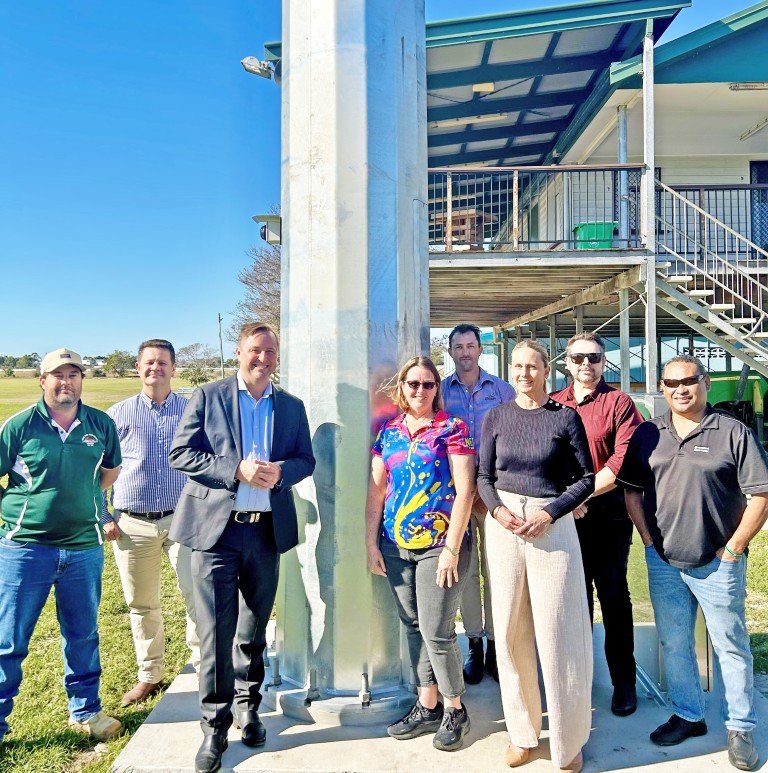
A major lighting upgrade at the Bowen Sporting Complex has been completed, paving the way for night games and future growth at one of the town’s key community hubs. The project delivered brand-new field lighting that meets the standards required for day/night cricket matches, as well as enabling night events for rugby and other sports, giving local players and visiting teams greater flexibility and opportunities to train and compete after dark. The upgrade was made possible through a $250,000
Read the full story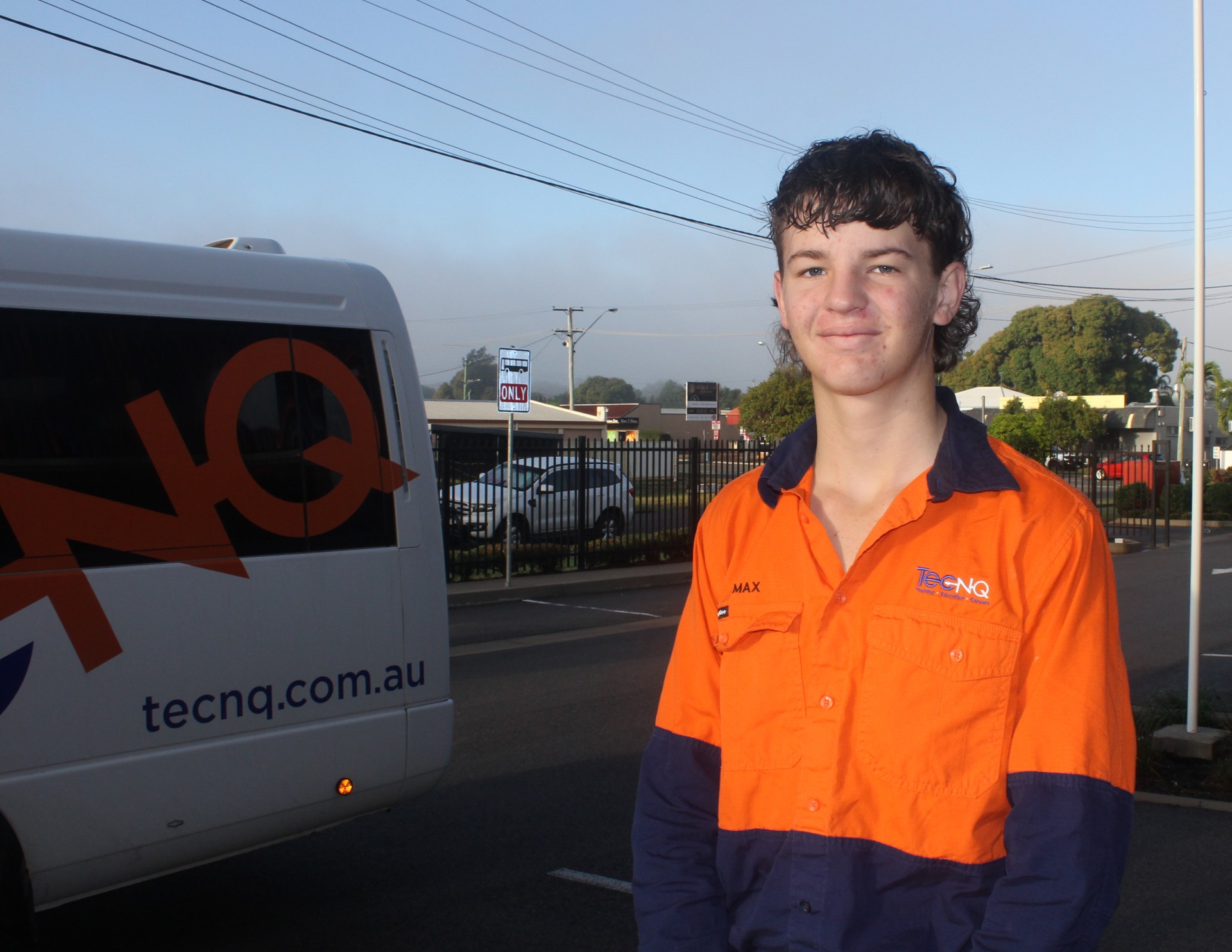
Tec-NQ House grade 11 boarding student Max has his boots firmly planted in two very different worlds: the rugged, hands‑on life of a central Queensland cattle station, and the bustling day‑to‑day routine of boarding school in Townsville. “I live on a station north of Clermont called Mazeppa,” Max explained. “When I’m not here at school, I live there with my family.” Home for Max is anything but quiet. Mazeppa Station is a working property that runs both cattle and crops, keeping everyone on th
Read the full story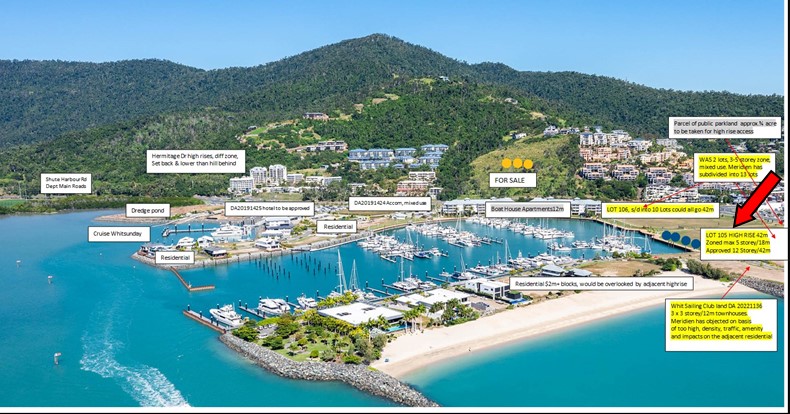
Local action group, Save Our Foreshore (SOF), are calling out for public support following news that legal action to fight the Council approved 47.7 metre high-rise development could amount to $150,000.
So far, all legal costs have been covered by donations but funds are running low and the legal costs are getting higher.
“To date we have paid for preliminary legal advice and all ongoing legal costs, including appearances of our solicitors and barrister to three preliminary hearings in Brisbane,” said spokesperson for SOF, Faye Chapman.
“We need to build our fighting fund now because prior to the actual seven-day court hearing our lawyers will require us to deposit funds in their Trust fund to cover the estimated costs of $150,000.”
SOF has engaged a planning expert, a visual impact expert and has also submitted laypersons statements in regards to visual impact, storm surge and community expectations.
The main point of contention is that the approved development at Port of Airlie exceeds the recommended building height level for the site and a high-rise hotel on this land will become an eye sore.
SOF also believe that the development goes against the small-town-feel upon which Airlie Beach has built its tourism brand.
An approved town plan from ten years ago detailed a three to four storey resort for the site with a leisurely lagoon and tropical surrounds.
Many feel that the new development completely contradicts this town plan and SOF managed to get over 2000 signatures to support their fight.
They are now looking for additional financial support from the community and can be reached through their Facebook page.
The site of the approved 47.7 metre high-rise hotel. Image supplied

Happy 2023!
A town of contrasts at the moment with many enjoying a well-earned rest whilst others are enjoying the buzzing of a fully booked town and people everywhere as visitors and locals alike enjoy the festive season in paradise.
With 2022 behind us, it is time to consolidate on what has been another extraordinary year for local businesses - generally in a positive sense. Yet again, the business community of the Whitsundays demonstrated strength, resilience, adaptability and innovation across all industries and the foundation has been laid for solid growth well into the future.
The Chamber will continue to provide independent advocacy, practical support and educational networking opportunity to further strengthen businesses in the region.
A huge shout out and thanks to the five businesses that generously supported the NYE fireworks in partnership with Council to set the sky alight in Airlie Beach. atHotel Group, Airlie Beach Hotel, Cruise Whitsunday, LiveLife Pharmacies and PRD each contributed $1000 to the event enjoyed by thousands.
Congratulates Clay Bauman on his successful campaign to be the councillor for Division 2 in a close finish. Our thanks also to the other candidates for putting their hands up to have an impact in the region.
Let’s not forget the Fair Work Legislation Amendment which will result in Industrial Relations changes in the following areas – Gender Pay Equality, Flexible Work Arrangements, Pay Secrecy, Fixed Term Contracts, Enterprise Agreements, Anti-Discrimination, Sexual Harassment, and the introduction of paid Family and Domestic Violence Leave.
In response to these changes, the Chamber’s first networking event in February will focus on these changes with a HR expert guiding us through new HR best practise. See you all then!
Contributed with thanks to President of Whitsunday Coast Chamber of Commerce, Alan Milostic.
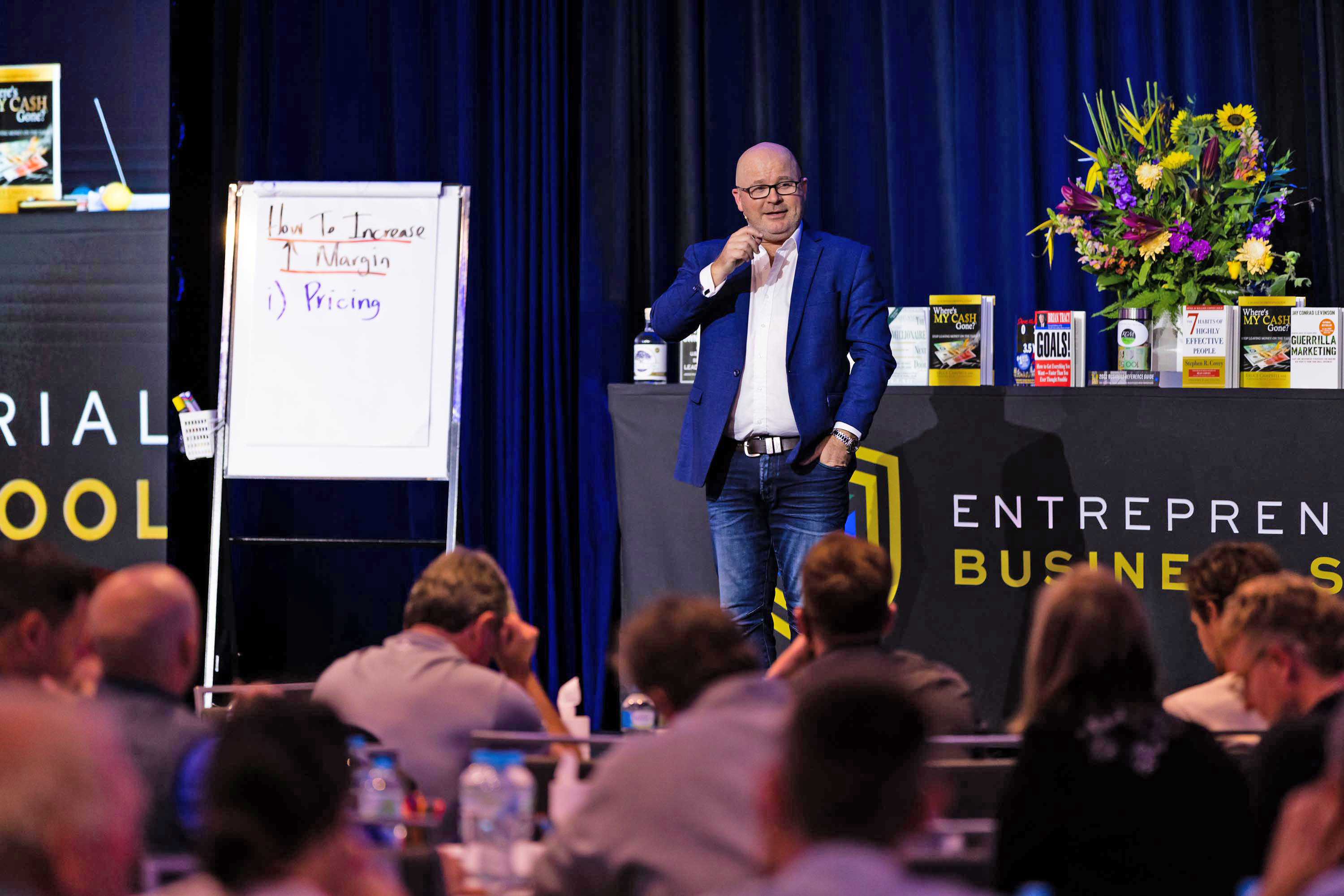
Business owners and those planning to purchase or start their own business are invited to a free business workshop at Coral Sea Marina later this month.
Attendees can expect to learn key skills such as how to track and measure numbers in order to make smarter decisions, turn your marketing into an investment instead of an expense and leverage your time to maximise efficiency and results.
Additional supportive information includes learning how to attract, train and retain exceptional employees that deliver outstanding customer service.
The workshop is facilitated by Entrepreneurial Business School (EBS), a Sunshine Coast based coaching firm which has helped thousands of business owners scale their practices so that they can eventually step out and let the enterprise run itself.
The event will be hosted by senior coach Wade Grundon who has operated his own business for many years and is an outstanding speaker.
During the workshop attendees will learn practical tools and will be given the skills to implement much of what they learn the following day.
Everything you need will be provided on the evening, including pen and paper.
“Simply turn up and be ready to listen,” said EBS marketing manager Tanya Proctor.
“We have hundreds of success stories, and it is not often you get a speaker of this calibre come to the Whitsundays.”
After the event, participants are invited to sign-up to the broader program which includes a community of thousands of business owners who attend a variety of events hosted by EBS Director and Master Business Coach, Bruce Campbell.
These include a six-monthly forum and large-scale functions which feature motivating speakers, inspiring case studies and avenues to set goals through further workshops.
WHAT: Free Business Growth Workshop
WHEN: Tuesday, January 17 from 5.30pm to 7pm
WHERE: Coral Sea Marina, Lookout Lounge
PRICE: Free
Senior Business Coach, Wade Grundon, delivers the free workshop
You can meet Wade at Coral Sea Marina later this month

Investors are reassured by a commitment to fix costs on luxury waterfront residences at the new Shute Harbour Marina Resort, a move that developers say will alleviate concerns about growing uncertainty with building prices.
The $350 million development project will include a large marina village with restaurants, retail outlets and a commercial heart.
In addition, there will be 58 luxury waterfront residences which will be located along the marina, each with their own private marina berth of between 25 and 35 metres.
“A key concern for buyers is the rapid increases and uncertainty surrounding building costs,” said Rob Taylor, of Taylors Property Specialists.
“The developers of Shute Harbour Marina are assuming this risk and giving price certainty to the buyer. Strictly limited numbers of guarantees are being made available.”
There are now two distinctive designs which have now been released at the fixed price of $3.45 million providing a collection of these luxury waterfront home-and-berth packages for this exclusive residential enclave.
“These packages offer incredible value to secure a waterfront home at Shute Harbour Marina Resort in one of the most exciting developments in north Queensland in years,” said Mr Taylor.
“Not only are the Whitsundays at your doorstep, but these homes will be just a short stroll from Pier 61, a world-class mixed use marine village that will be the commercial and retail heart of Shute Harbour Marina Resort.”
The Tropicana and The Whitsundays are the two choices available at the fixed price.
The Tropicana’s two-storey main residence delivers an expansive 295sqm of enclosed living areas.
The upper-level master bedroom features a private owner’s study/retreat and deck, while the spacious second and third bedrooms are located in a private pavilion with undercover walkways connecting the pavilions.
The residence comes complete with a cooling plunge pool and the 25-metre berth right at its doorstep.
The Whitsundays delivers a modern three-bedroom design that captures incredible views of the marina.
This two-storey design is equally as spacious, with 295sqm of enclosed living areas and 2.7-metre-high ceilings helping to maximise the open areas on the lower level which are ideal for entertaining and relaxed tropical living.
A generous master suite is located on the upper level and the residence is completed with an 8 x 2.5-metre swimming pool overlooking a 25-metre marina berth.
Luxury living at a fixed price – new $3.45 million waterfront residences at Shute Harbour Marina Resort. Photos supplied

Kind volunteers spent their Christmas Day hosting a free community lunch at Whitsunday PCYC and over 60 people, many of them elderly, came along to share in friendship and food.
Paula Hovey and Phil Ruck cooked up an incredible festive spread with all of the contents donated by local businesses – Whitsunday Foodservices, atHotel Group, Fish D’Vine, Proserpine IGA, Whisper Gin Bar and Airlie Beach Bowls Club.
The event was organised by author of PJ’s Food Diary, Paula Hovey, Councillor Jan Clifford and Ingrid Ruck from Proserpine Community Centre.
There were also a host of volunteers who spent the day putting smiles on faces and gifts in hands.
One volunteer, Helen Pike, even found an older gentleman at the bus-stop on his way home and offered him a lift to the event where he was filled up and made to feel special.
“It makes us really happy to be able to do it and know that people aren’t by themselves on Christmas Day,” said Paula.
Two of the organisers – Councillor Jan Clifford and Paula Hovey
Everyone enjoyed a colourful Christmas spread at Whitsunday PCYC. Photos supplied
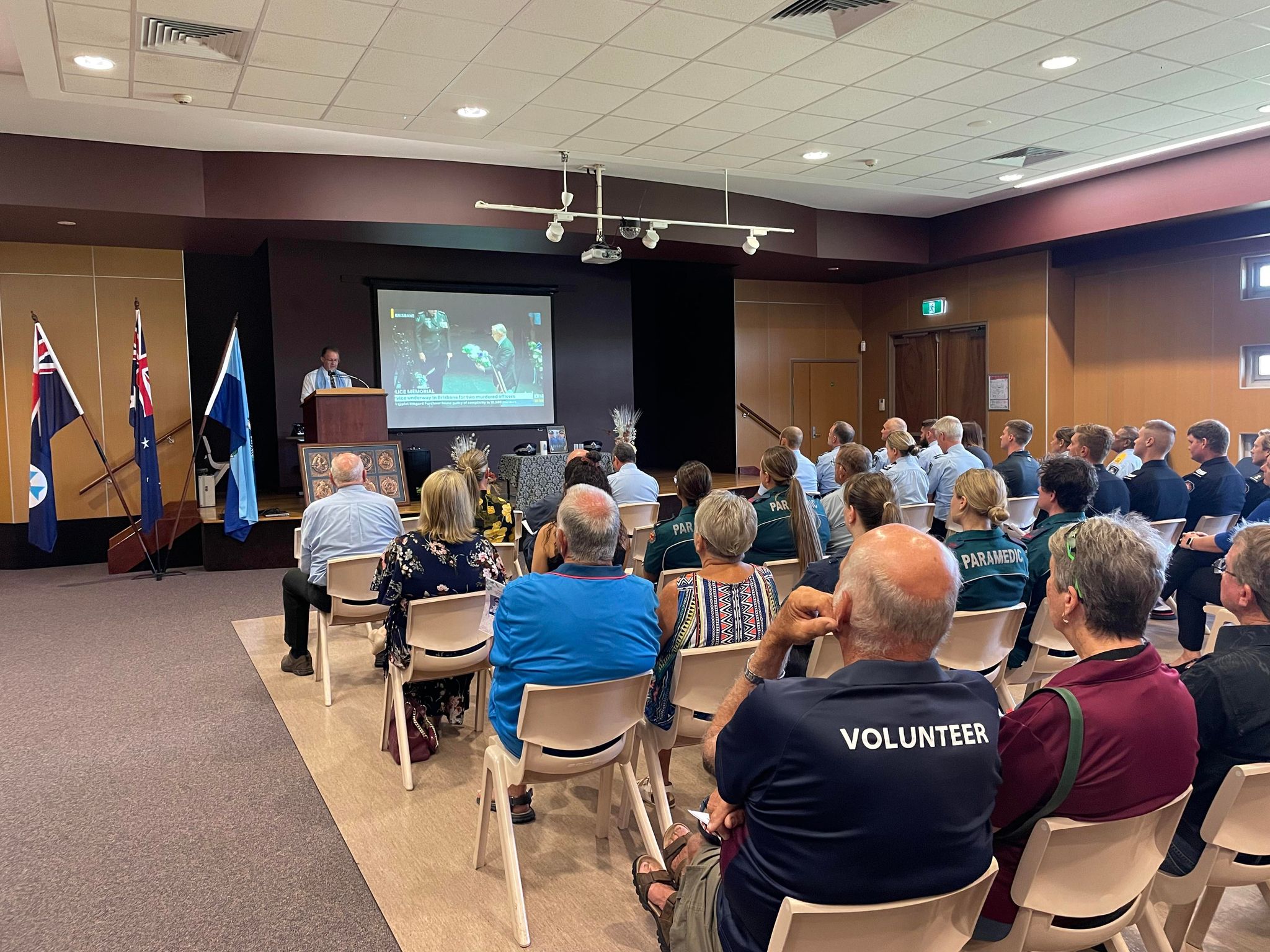
Over 70 emergency services personnel, families and members of the public attended a special service in Bowen which was held to remember the fallen officers who passed away in the Wieambilla shooting just before Christmas.
Matthew Arnold, 26, and Rachel McCrow, 29 were both ambushed and murdered in a pre-planned attack by three assailants from the same family.
Four officers attended the scene to conduct a welfare check and two managed to escape - Constable Keely Brough, 28, who raised the alarm as she was hunted by the attackers and Constable Randall Kirk, also 28, who was shot in the leg.
The incident sent shockwaves across the country when it occurred on December 12 last year and dozens of ceremonies to honour the fallen and their families were held in multiple locations on December 21.
The Bowen service was officiated by the Whitsunday Police Chaplain who led a small local service prior to the live stream.
Retired Police Sergeant David Blundell read the Police Ode and Councillors Mike Brunker and Michelle Wright attended to pay their respects on behalf of Whitsunday Regional Council.
Over 70 people attended a special service in Bowen which honoured the fallen police officers
Police Officers Matthew Arnold and Rachel McCrow died in December. Photo credit: Queensland Police Union
Wreaths were laid outside the Bowen Police Station in their honour

We spend all our working week with the same group of people, fulfilling the same set of duties, something’s bound to start getting on your nerves. Why do our co-worker’s tick us off? Why do some people’s communication drive us crazy?
Learning how to handle different personalities is the first step to creating the workplace where we all want to be.
Invest in three hours a month to step out of work and start working on how to do things better.
You will quickly create and enjoy:
· Staff who are more motivated – which means they’re more likely to go above and beyond for your business
· Increased productivity and efficiency. A trained team wastes fewer resources, money and time, and they’ll produce a higher quality of work
· A trained workplace is a safe one. If you’ve trained your staff, you’ll reduce the number of accidents and incidents, which can be insanely costly
· A consistently awesome customer experience – increased loyalty and great reviews
As you embark on 2023 why not invest in your people and see how Shiift can create positive, sustainable change with minimal effort.
It’s easier than you think.

Over the past weeks, we have been featuring stories on various water quality projects being delivered in the Mackay Whitsunday region, which are funded by the partnership between the Australian Government and the Great Barrier Reef Foundation. Regional programs, like those being delivered here in the Whitsundays, seek to work with landholders to refine farming practices now and into the future, leading to enduring water quality improvement.
To date nearly 400 farm-level projects are underway in the Mackay Whitsunday region, with all contributing to specific targets on reduction of pesticides and nutrients entering the Great Barrier Reef lagoon.
The Mackay Whitsunday Water Quality Program (MWWQP) targets are to reduce losses of Dissolved Inorganic Nitrogen (DIN) by 26 tonnes and pesticide active ingredients by 215 kilograms. Now over halfway through the program, modelling shows that these targets are expected to be met or exceeded by the completion date of June 2024.
Chris Dench, Program Manager for the MWWQP said that “the reporting to date is encouraging, and the significant uptake of projects in our region highlights the commitment of growers to improve water quality on farm and consequently the quality of water that flows to the reef.”
The overall target of all regional water quality programs in Queensland is to reduce 457 tonnes of DIN, 463 kilotonnes of fine sediments and 250 kilograms of pesticides from entering the Reef.
More than 800 farmers and graziers to date are involved in projects that have contributed to the 187 tonnes of nitrogen, 229 kilograms of pesticides and up to 37 kilotonnes of fine sediment prevented from entering the Reef each year so far (GBRF Progress Dashboard).
Reporting on the outcomes of the projects from all regional programs is through the Paddock to Reef integrated monitoring, modelling and reporting program (Paddock to Reef) which is jointly funded by both the Australian and Queensland Governments.
For more information on the Mackay Whitsunday Water Quality Program or Paddock to Reef please visit www.reefcatchments.com.au
Contributed with thanks to Reef Catchments.
Nearly 400 farm-level projects are underway in the Mackay Whitsunday region, aiming to reduce the number of pesticides entering the Great Barrier Reef lagoon. Photo: Stock image

Sea level rises are not new. Following the last Ice age, as the world began to warm causing the massive polar ice caps to melt, sea levels all around the world began to rise. Over a period of 12,000 years (between 18,000 and 6000 years ago) the sea levels rose more than 120 metres.
Although this happened erratically, with some very rapid rises and some halts, this does average out at a rise of 1 centimetre a year - or half a metre in the lifetime of someone who lived to the age of 50 - and must have come as a shock to the people who experienced them. Although there have been many fluctuations, it had been over 100,000 years since sea levels were high enough to flood the Torres Strait and Bass Strait. Before then, continental shelves all around the world had long been dry land.
About one-seventh of the land mass which was the Australian continent at the end of the Ice age - two and a half million square kilometres - became submerged. This is equal to the present state of Western Australia. When rising quickly, the sea is likely to have drowned gently sloping plains in Northern Australia at the rate of 5 kilometres a year, inundating strips of land over 100 kilometres wide within a generation. Where the continental shelf sloped more steeply the rise would have been less dramatic but would have impinged on the people's lives nonetheless - and they would have had no way of knowing that the sea would ever stop rising.
Memories of this sea level rise is preserved in mythology. All around the world there were tales of floods. Aboriginal and Torres Strait Islander stories are particularly rich in references to inundation. Damarri, a Dreamtime figure of the Gungandji Aboriginal people, from the Cairns area was caught out as the sea levels rose but managed to stop the flood by heating stones in a fire and throwing them into the sea. The rocks can still be seen, off the coast at Yarrabah.
Land which was inundated was not 'lost' to the people who traditionally include it in their tribal territories. For many indigenous people's both land and sea, and the creatures which lived there, have a spiritual significance which is intimately linked to their particular creation beliefs and that sense of attachment was not destroyed simply because some of the land was covered with sea. New creation stories explain the origins of Islands and reefs and the inundated territory became 'sea country'.
See the Reef, Love the Reef, Protect the Reef.
Contributed by Master Reef Guide Brent Chatterton.
Aboriginal stories spoke of inundated territory that became ‘sea country’

With storm season in full swing, we are all reminded not to get complacent, but to keep vigilant and prepared in case a severe weather event comes our way.
On average, 11 cyclones hit Australia each year and four of them are likely to cross land.
While this may not seem like a lot, it only takes one to cause extensive damage.
In March 2017, Cyclone Debbie hit the Whitsundays and large areas were without water for over a week and had no electricity for two weeks.
During this time, residents needed to be self-sufficient and resilient.
Will you be prepared if this happens again this year?
Here’s what you need to do:
• General maintenance: check the condition of your roof tiles, clean out gutters, trim trees and secure lose items
• Home preparation: Make sure you have an emergency pack, a torch and batteries, wide masking tape for windows, containers for water, spare fuel, portable gas stove top or BBQ and hessian bags
• During a severe weather warning: Close windows or shutters, fill buckets and bath with clean water, park vehicles under cover, move all family members to the strongest room of the house
• Keep connected: Listen to the radio and head to the Whitsunday Regional Council Disaster Dashboard where you will be able to keep up with real time information about the weather event
Cyclone season takes place from November to April each year and the Bureau of Meteorology (BOM) will issue warnings when a severe weather event is expected to hit within 24 hours.
During this small window the shops may be full, and supplies can run out so it is best to ensure you are prepared ahead of time.
Cyclone Debbie hit in 2017, causing residents to be without power for weeks. Photo contributed
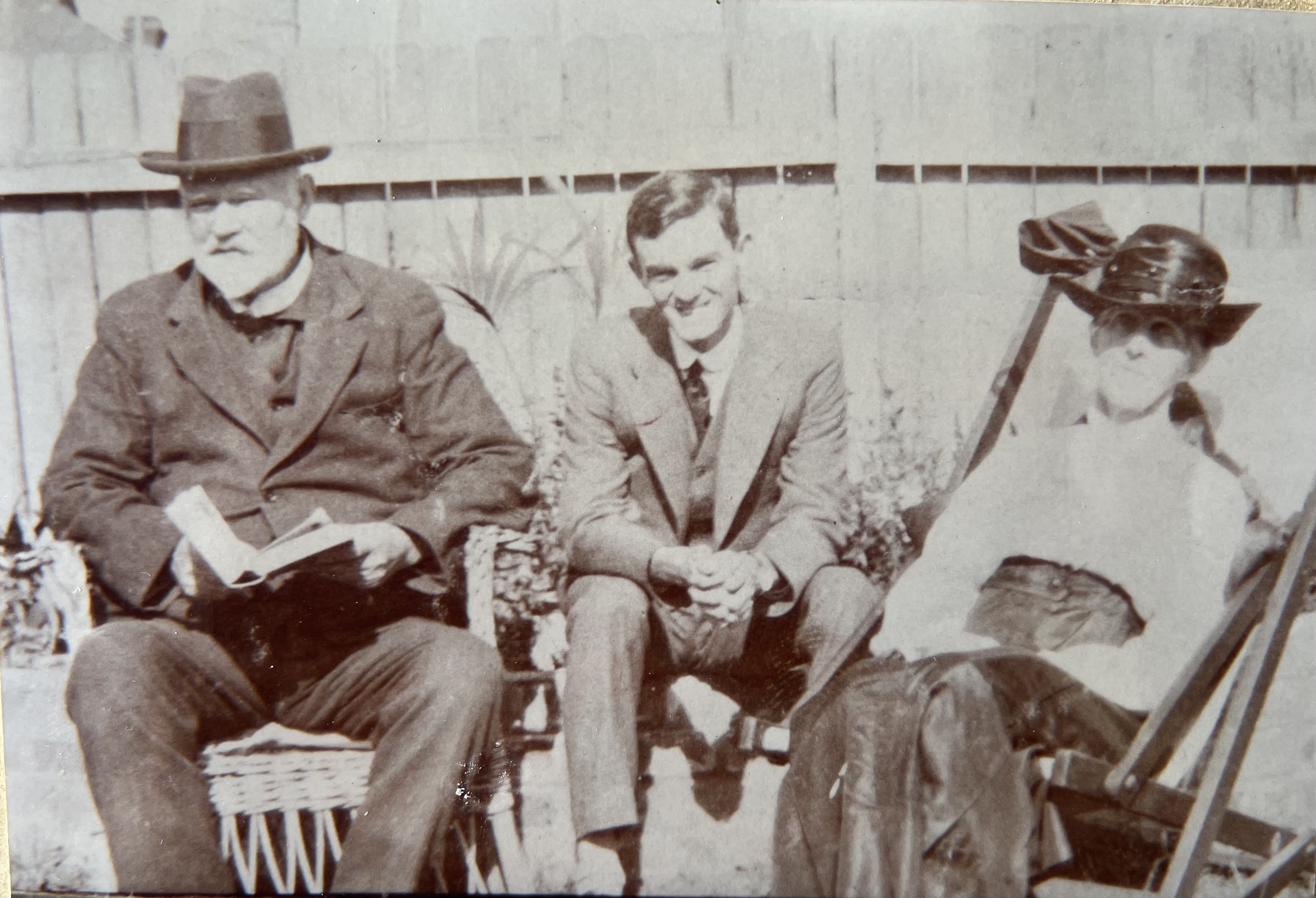
Despite its geographical proximity to Bowen and Mackay in today’s travelling time, Proserpine was still a remote town at the turn of the 20th century with no railway connections and very rough roads. There was no resident doctor and no pharmacy. For most ailments, people relied on traditional remedies such as castor oil and senna pods. Messrs Gus Waite and Jim Webb, both with rudimentary medical training, gave relief to people suffering from toothache and may have rendered first aid in accidents. Childbirth was in the hands of midwives, mostly untrained but well experienced. Dr Traill, from Bowen, occasionally braved the road to provide a minimal service.
Although it is uncertain as to exactly when Dr Anderson came to Proserpine, there are references to his presence in this district in the “Port Denison Times” in the 1903/04 era. Henry Anderson was an undergraduate at the Royal University of Ireland and graduated as Bachelor and subsequently Master of Arts. He turned his attention to medicine and in 1884 obtained the Degree of Doctor of Medicine, taking up practice in Manchester, England. He came to Queensland in 1899 and began to practice in Thargomindah. Country life always appealed to him, and he practiced in turn in Springsure, Proserpine, Harrisville, St. George and Maleny.
By 1910, Dr Anderson was firmly established in Proserpine. He bought two acres of land in what is now Faust Street where the water tower stands today. There he built “Parkfields”, a beautiful home which included a surgery and private hospital and “The Grange”, next door, for his widowed father. This home was bought by the Faust family in 1915.
Dr Anderson played an active role in the rapidly developing town. He supported the establishment of an Ambulance Brigade, offering to give a course on first aid, and later served on the committee.
Early editions of the “Proserpine Guardian” attest to an amazing variety of medical and surgical emergencies, epidemics and accidents with which Dr Anderson had to cope – with rudimentary equipment and only very basic drugs and with little help from outside sources. There were no pathology services, X-rays or antibiotics and he even had to dispense his own drugs. There was little chance of consultations with other doctors and, until the hospital opened, few trained nurses. Yet he provided a general medical coverage of the entire town and shire and obtained remarkable cures, gaining the respect of most of the community.
In 1911, when a public hospital was built after much community pressure, Dr Anderson was appointed Medical Officer and empowered to purchase the necessary instruments and drugs. Over the years, he served the hospital in many ways - as administrator, surgeon, physician, obstetrician, psychiatrist - and came up against many problems. He was constantly recommending measures that would improve the efficiency of the hospital.
Despite being a respected doctor, he never seemed to have a comfortable relationship with the Management Committee. He felt that they were all business men who did not appreciate the right and responsibility of the Medical Superintendent to make all decisions concerning the care and treatment of patients. This conflict came to a head on numerous occasions.
Dr Anderson continued as doctor in charge and in private practice until he resigned in 1918. This was deeply regretted by many and affirmed by the large farewell given by the local community. He continued to practice in various small towns in Queensland until he retired to Sydney in 1921 and died there in 1924.
Story courtesy Proserpine Historical Museum; photo source from Mrs Zena Price
Dr and Mrs Anderson with their son, later Dr Hugh Anderson

When Melinda Hutchings survived anorexia in her teenage years, she knew there would come a day when she would be able to share her story and help others through their own journeys.
It took her a decade to reach a place where she felt ready, but once she arrived at that moment, she was able to write her first novel in just six months and describes it as a complete outpouring of her heart and a “cathartic” experience.
“Anorexia is an insidious disorder and once it takes hold it’s very difficult to understand, and even more difficult to recover from. It is also hard for the people around you. It can be very difficult for loved ones to understand what I was going through,” said Melinda.
“Creating my first book was a very emotional experience and I would feel all those emotions again when I was writing it, so it was very hard. But then writing was another sense of letting go.”
Her novel Fighting for Life: Anorexia The Road to Recovery which came out in 2000, is a fictional story that details Melinda’s journey but is written in the third person so that it is more relatable.
“I had a desire to change my negative experience into something positive and write my story as a work of fiction so that other people can read it and something in the journey of the main character may speak to them,” Melinda explains.
“I thought it would have more power and help more people if it was written that way.”
The book details the full journey of how the eating disorder took hold, the depths of the pain and then gives tools and advice for recovery and finding a way out.
Since its release, the book has inspired thousands of people and helped countless families understand what their loved ones are going through.
For Melinda, that is the most important part, and she recounts with tears in her eyes how she received one email that said: “I am well on the way to recovery and one of the reasons is you”.
After the success of her first book, Melinda released her second which was a compilation of stories from people who had lived through eating disorders.
Shortly afterwards, Melinda joined the authors circuit and spoke to large audiences, helping people understand more about the disease.
During this time, she made media appearances and became an inspiration to many.
In 2009 Melinda published Why I Can’t Look The Way I Want through Allen & Unwin which further cemented her career as a successful author.
Taking a break from the spotlight, she has focused on other projects for some time and recently moved from Sydney to the Whitsundays with her partner.
Melinda is now working on her next non-fiction book which is an inspirational story to help people embrace change and overcome adversity.
She is also ghost writing and editing a non-fiction book that has the potential to become an international best seller.
“For the person that is suffering right now, it is really important that they feel supported and loved and especially heard,” said Melinda.
“It can be very challenging for the people around you, but it is important that they just keep being supportive because that person needs you so much – it’s a difficult journey to understand and everyone’s journey is different - as hard as it is, just keep being there.”
Author Melinda Hutchings shares her story of surviving anorexia

As the holidays draw to a close many families have a mixture of feelings. While it is sad to see the excitement and fun of summer days and free time disappear, many parents may secretly be looking forward to the return of the school routine and less time juggling playdates between work commitments.
Whatever the new school year means to you and your family, it is undoubtedly important to start getting prepared in the final few weeks of the holidays. Build an air of excitement around the new year, get engaged with your children’s learning and set goals for your family.
Here are a few ideas that could help you along the way:
Encourage
Similar to adults, children will feel motivated by setting achievable goals that are presented in a fun and engaging way.
In fact, research shows that kids who participate in setting learning goals are consistently more motivated and take learning more seriously.
Ask your children what they want to aim for this year, what they would like to improve or challenge themselves with.
Engage
It is important that you engage with your child’s curriculum so you can understand areas they may need to improve and also be there to assist with any stress triggers as they arise.
Most kids deal with some level of stress or anxiety about school. One survey found that 53 per cent of parents cite homework and schoolwork as the greatest driver of stress in their kids.
You do not need to know the answers to their homework, you simply need to know what they are being asked to complete.
Prepare
On the week before school starts it could be a good idea to begin a new routine which is conducive to longer days of study, giving them energy to last all day.
A big part of this is ensuring children have enough sleep and, during school holidays, bedtimes often get thrown out of whack.
Try instilling a rule of no technology an hour before bed and gradually bringing their bedtime back to school suitable hours, that way the transition is not so much of a shock.
Get Excited!
Granted, holidays are fun and free whilst school terms can be more about structure and schedules, but that doesn’t mean you can’t add a little excitement to the start of a new school year.
Going shopping for school supplies together and letting kids pick out their own pens, notebooks and other school supplies can help them get excited about going back to school, even if it means the shopping trip might take a bit longer.
Also keep in mind that kids are often quick to pick up on our attitudes towards things, so try to speak positively about school and emphasise the positive aspects of it, such as their friends and teachers or the cool things they’ll have a chance to learn.
Information in the article sourced from Marianne Stenger from Open Colleges Australia.

Here in the Whitsundays, we are lucky to have beautiful and accessible nature at our doorstep and, in the cool of the morning or late afternoon, our parks and green areas are full with the sound of children’s laughter.
When the new school term starts, however, it is very easy to slip into a routine where outdoor play is replaced by technology, tired eyes are easily occupied by a screen.
With recent studies showing that the average American child spends just four to seven minutes a day playing outside and a whopping seven hours a day in front of a screen, it is now more important than ever to get our children outside.
Kids who play outside are known to be happier, better at paying attention and less anxious than kids who spend more time indoors.
Here are some other advantages:
It builds confidence - Letting your child choose how they treat nature means they have the power to control their own actions.
It provides different stimulation – while technology can appear stimulating, it can actually be numbing. Outside activates more senses where you can see, hear, smell, and touch outdoor environments.
It gets them moving - Not only is exercise good for kids’ bodies, but it seems to make them more focused, which is especially beneficial for kids with ADHD.
It makes them think - Nature creates a unique sense of wonder for kids that no other environment can provide. This encourages kids to ask questions about the earth and the life that it supports.
It reduces stress and fatigue - urban environments require directed attention, which forces us to ignore distractions and exhausts our brains. In natural environments, we practice an effortless type of attention known as soft fascination that creates feelings of pleasure, not fatigue.
Information sourced from Danielle Cohen from the Child Mind Institute.
DID YOU KNOW?
• Children can laugh up to 300 times a day, the average adult only laughs about 20 times
• Babies under the age of one do not understand the difference between right and wrong
• A four-year-old will ask on average 437 questions a day
Fantastic Facts For Kids
• Caterpillars have 12 eyes
• Horses and cows sleep standing up
• Wombats do square poos
• A hippo can run faster than a man
• Kangaroos can't walk backwards
• A shark is the only fish that can blink with both eyes
• A group of frogs is called an army
• Octopuses have blue blood and nine brains
• Gorillas burp when they are happy
• Emperor penguins can last 27 minutes underwater
• Slugs have four noses!

Deciding on the right pair of shoes for your child is an important part of the back-to-school process – of all the ‘tick list’ items you need to get your children prepared for the start of a brand-new year, giving them the solid foundations of quality and supportive footwear is paramount.
At Shoe Biz, the Whitsunday’s premier footwear supplier, the passionate team will welcome you into their store and treat each foot individually, just like they treat each person.
The family run business has been operating for over 30 and has two stores, one in Airlie Beach town centre and a second on Proserpine Main Street.
General Manager Andrew Allison says that, after all this time, it is the people they serve that matter most.
“It’s the generations and generations we get to serve,” he said.
“Most people know me, we’ve seen families come through, kids, parents, grandparents – those kids are now having their own kids – it’s like one big family!”
Andrew’s parents, Richard and Pamela bought the business in the early 1990’s because they wanted to create a place where all their family could work.
Both their children and grandchildren have grown up and worked in the stores over the years and, with Richard recently retiring, Andrew oversees operations while Pamela looks after the administration side of the business.
Andrew has been working in the business since the family purchased it, and he says that fitting shoes properly is a skilled part of the job that he has perfected over the years.
“We fit them, and we fit them properly to make sure they are comfortable,” he said.
“We are experienced and over the years customer feedback has meant that we only stock the best brands at a range of price levels to suit any budget.”
From Assics and Sketchers through to the more affordable Sfida, Shoe Biz only supply brands that they vouch for themselves.
Every customer is offered a personal fitting service as part of the price, as well as the “good old fashioned service” which is always included.
You will always see Andrew or Pamela there to greet you at the Airlie store while Liz DeMartini will welcome you at the Proserpine location.
Shoe Biz General Manager Andrew Allison with mum Pamela in the background